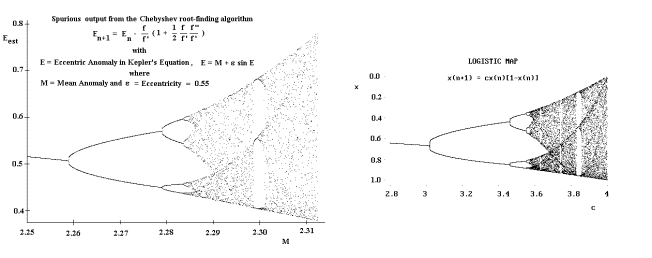Physics
Seminar
|
Randall D. Peters |
Wednesday,
Jan 19, 2005, 4:30pm |
|
|
|
|
Some
Mathematical Foundations |
|
|
To the uninitiated there appears to be a great
divide between the way mathematicians and physicists study the ‘new
science’ of chaos. A primary
difference between their modeling methods can be shown to result from the
choice of size for a time-step. Physicists
generally prefer to describe a system in terms of state variables (such as
position and velocity) which vary continuously with the time t; whereas
mathematicians prefer to work with ‘maps.’
As will be shown in this seminar, the connection between these two
representations can be greatly clarified by applying the methods of
Hamiltonian mechanics when generating the differential equations of motion. The motion thus prescribed is naturally approximated (for
computer analysis) by means of coupled, lower-order finite-difference
equations involving δt. These
can be used to either (i) generate graphs to show the evolutionary character
of the system as preferred by physicists, through working with a small δt
(to produce time-plots, or phase-space plots, or Poincare’ sections); or to
(ii) produce an associated map that is preferred by mathematicians, by setting
δt = 1. Some examples will
be given, including the Chirikov (or standard) map that is intimately related
to the chaotic pendulum. (A 1993
photograph of plasma physicist Chirikov will be shown, taken in Russia by
Peters while visiting Novosibirsk, Siberia)
A two dimensional map discovered by Peters, through the study of a
torsion-gravity pendulum (http://physics.mercer.edu/petepag/pend.htm),
will be discussed. Depending on
the size of a single parameter, this map is able to express features of three
different and important physical systems: (i) the harmonic oscillator, (ii)
the Duffing oscillator, and (iii) the chaotic pendulum. Best known through the
one-dimensional map known as the logistic equation, the period doubling route
to chaos will be discussed in terms of the fundamental constant discovered by
physicist Mitchell Feigenbaum. The
practical importance of the Feigenbaum constant δ=4.699s… (c.f., http://mathworld.wolfram.com/FeigenbaumConstant.html)
is still largely unknown. One
hint of its importance will be shown where an attempt to solve Kepler’s
equation by means of an ‘improved Newton’ (Chebyshev) method met with
spurious results analogous to the period-doubling route to chaos in the
logistic equation. |
|
Please
join us for light refreshments at 4:15pm outside WSC 109.
